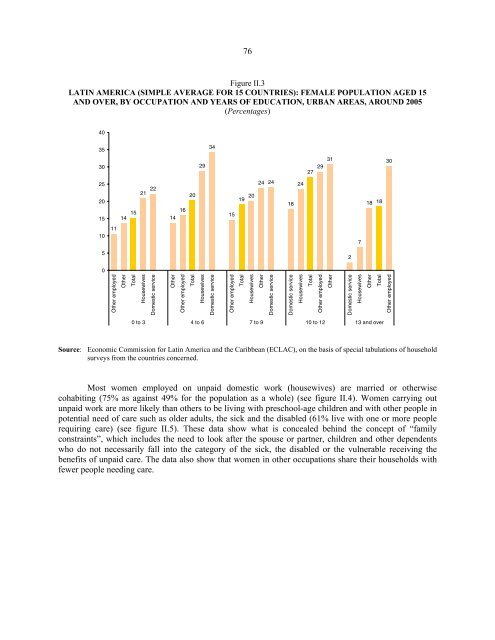Women in Latin America and the Caribbean - Cepal
Women in Latin America and the Caribbean - Cepal
Women in Latin America and the Caribbean - Cepal
Create successful ePaper yourself
Turn your PDF publications into a flip-book with our unique Google optimized e-Paper software.
76<br />
Figure II.3<br />
LATIN AMERICA (SIMPLE AVERAGE FOR 15 COUNTRIES): FEMALE POPULATION AGED 15<br />
AND OVER, BY OCCUPATION AND YEARS OF EDUCATION, URBAN AREAS, AROUND 2005<br />
(Percentages)<br />
40<br />
35<br />
34<br />
30<br />
25<br />
20<br />
15<br />
14 15 21 22 14<br />
16<br />
20<br />
29<br />
15<br />
19 20 24 24<br />
18<br />
24<br />
27<br />
29<br />
31<br />
18 18 30<br />
10<br />
11<br />
7<br />
5<br />
2<br />
0<br />
O<strong>the</strong>r employed<br />
O<strong>the</strong>r<br />
Total<br />
Housewives<br />
Domestic service<br />
O<strong>the</strong>r<br />
O<strong>the</strong>r employed<br />
Total<br />
Housewives<br />
Domestic service<br />
O<strong>the</strong>r employed<br />
Total<br />
Housewives<br />
O<strong>the</strong>r<br />
Domestic service<br />
Domestic service<br />
Housewives<br />
Total<br />
O<strong>the</strong>r employed<br />
O<strong>the</strong>r<br />
Domestic service<br />
Housewives<br />
O<strong>the</strong>r<br />
Total<br />
O<strong>the</strong>r employed<br />
0 to 3 4 to 6 7 to 9 10 to 12 13 <strong>and</strong> over<br />
Source: Economic Commission for Lat<strong>in</strong> <strong>America</strong> <strong>and</strong> <strong>the</strong> <strong>Caribbean</strong> (ECLAC), on <strong>the</strong> basis of special tabulations of household<br />
surveys from <strong>the</strong> countries concerned.<br />
Most women employed on unpaid domestic work (housewives) are married or o<strong>the</strong>rwise<br />
cohabit<strong>in</strong>g (75% as aga<strong>in</strong>st 49% for <strong>the</strong> population as a whole) (see figure II.4). <strong>Women</strong> carry<strong>in</strong>g out<br />
unpaid work are more likely than o<strong>the</strong>rs to be liv<strong>in</strong>g with preschool-age children <strong>and</strong> with o<strong>the</strong>r people <strong>in</strong><br />
potential need of care such as older adults, <strong>the</strong> sick <strong>and</strong> <strong>the</strong> disabled (61% live with one or more people<br />
requir<strong>in</strong>g care) (see figure II.5). These data show what is concealed beh<strong>in</strong>d <strong>the</strong> concept of “family<br />
constra<strong>in</strong>ts”, which <strong>in</strong>cludes <strong>the</strong> need to look after <strong>the</strong> spouse or partner, children <strong>and</strong> o<strong>the</strong>r dependents<br />
who do not necessarily fall <strong>in</strong>to <strong>the</strong> category of <strong>the</strong> sick, <strong>the</strong> disabled or <strong>the</strong> vulnerable receiv<strong>in</strong>g <strong>the</strong><br />
benefits of unpaid care. The data also show that women <strong>in</strong> o<strong>the</strong>r occupations share <strong>the</strong>ir households with<br />
fewer people need<strong>in</strong>g care.











